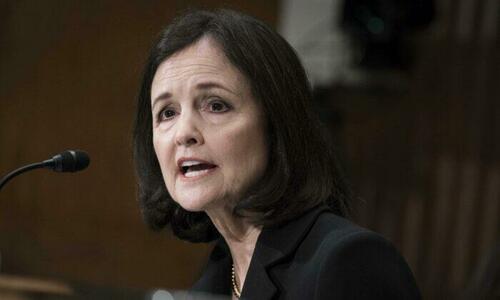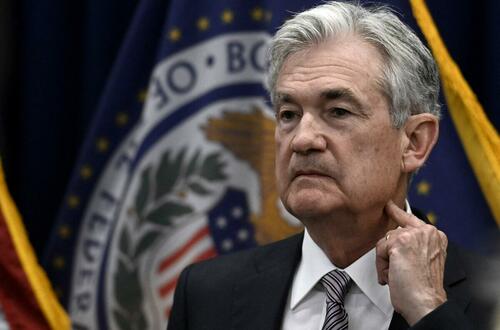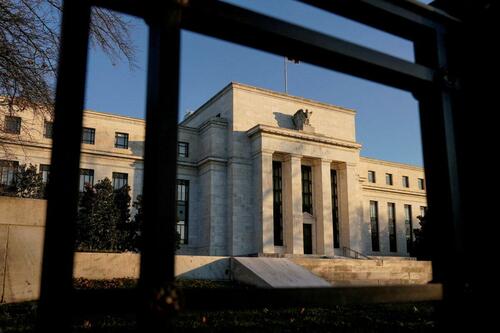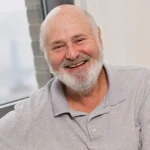
Authored by Andrew Moran via The Epoch Times,
Jerome Powell and the Federal Reserve have been on a crusade to navigate the U.S. economy to a soft landing rather than a hard crash as it struggles to fight 40-year high inflation while averting a recession.
Can the central bank achieve this ostensibly difficult objective?
If the central bank’s track record is anything to go by, the Fed is “not omniscient,” says Judy Shelton, a senior fellow at the Independent Institute and former Federal Reserve board nominee, in a wide-ranging interview with The Epoch Times.
According to Shelton, it will be challenging to prognosticate the lasting effects of pushing up the benchmark Fed funds rate to a neutral level after exerting tremendous influence on the economy for the last two years.
“I think it’s also hard to say what will be the impact and what will be the timing of the impact of ratcheting up interest rates to the point where they choke off real economic activity,” she said. “There’s a big difference in saying money that comes from speculating on money that can generate income, versus GDP growth that reflects an increase in the level of goods and services available.”
Jerome Powell departs after taking the oath of office for his second term as Chair of the Board of Governors of the Federal Reserve System at the Federal Reserve Building in Washington, on May 23, 2022. (Olivier Douliery/AFP via Getty Images)
A key hurdle that the Fed will need to overcome is having the real interest rate higher than the inflation rate, notes Shelton. In addition, the neutral rate—a rate that neither supports nor restricts economic growth—would need to run higher than what officials forecast price measurements will be at the end of the year, be it the consumer price index (CPI) or the personal consumption expenditure (PCE) price index.
“If the Fed is looking at pushing up the Fed funds rate to 2.4 or 2.5 percent, but inflation is running anything higher than let’s say 1 percent, then you’re still effectively having interest rates serving as a stimulus in the Keynesian sense,” she explained.
“The Fed would have to get in front of that. I don’t think they would do that.”
But the institution’s “whatever it takes” approach to combating inflation “is not an admirable solution,” according to the former U.S. executive director for the European Bank for Reconstruction and Development.
Powell acknowledged last month at a post-FOMC press conference that when the Fed reaches its neutral rate roughly at the end of the year, the Fed could tighten policy even further “if that turns out to be appropriate.” This would make borrowing costlier, but it would also restrain economic growth.
Financial markets are pricing in a benchmark rate as high as 3.6 percent by the middle of next year, although St. Louis Fed Bank President James Bullard has repeatedly purported that he wants to get to 3.5 percent by the year’s end. If the Fed does accelerate its rate hikes, this would be the highest interest rate in about 15 years.
The rate-setting Federal Open Market Committee (FOMC) will be holding its next two-day policy meeting later this month. It is widely expected that officials will vote to approve a 50-basis-point hike.
In addition to consumers losing more than 8 percent a year in purchasing power, higher interest rates will also cause financial strain on many households that took on greater debt levels, asserts Shelton.
This is why she believes it has become a mistake to allow a small group of people to determine what the price of capital should be, suggesting that it might be time to adopt a more market-oriented approach to interest rates.
“I think we need to bring market forces into determining the price of capital, which is the interest rate on the basis of supply and demand, and have a more organic approach to calibrating the level of cash and credit to the needs of a productive economy,” Shelton said.
Fundamental Monetary Reforms
Overall, Shelton does not think the Federal Reserve has done a good job since the beginning of the coronavirus pandemic. But while missing the mark on inflation has severely hemorrhaged its reputation, the fact that the Fed has turned into “too big a factor in determining economic outcomes” is the problem.
“I think that they deployed the airbag in March 2020. I believe that they did not understand, at the Federal Open Market Committee, the need to get the car back on the road,” the economist stated.
“I think the Fed is far too big a factor in determining economic outcomes. I think that it is exerting too much influence over financial markets.
After attempting to control the money supply by manipulating interest rates, the central bank’s only recourse in managing price stability “is to kill the economy.”
In this environment where many economic experts believe the Fed has destroyed its credibility by claiming for nearly a year that inflation would be transitory, is it time for changes to monetary policy?
The Federal Reserve building in Washington on Jan. 26, 2022. (Joshua Roberts/Reuters)
Shelton has not been shy about her support for fundamental monetary reforms.
In April 2019, Shelton wrote an op-ed in The Wall Street Journal titled “The Case for Monetary Regime Change.” She argued that it would be “entirely prudent to question the infallibility of the Federal Reserve in calibrating the money supply to the needs of the economy.”
Years later, she is still championing fundamental change at the Fed.
“I think that we might be reaching a point where people are so unhappy with the way the Fed has evolved into having such control over the economy, that they may be ready, now, to consider something along the lines of what was proposed and passed in the House in 2015, which was to have a monetary commission to really evaluate alternative monetary regimes,” Shelton averred.
“I really think central banking may have run its course. I think that we’re seeing that the tools the Fed uses now are damaging to productive economic activity.”
Authored by Andrew Moran via The Epoch Times,
Jerome Powell and the Federal Reserve have been on a crusade to navigate the U.S. economy to a soft landing rather than a hard crash as it struggles to fight 40-year high inflation while averting a recession.
Can the central bank achieve this ostensibly difficult objective?
If the central bank’s track record is anything to go by, the Fed is “not omniscient,” says Judy Shelton, a senior fellow at the Independent Institute and former Federal Reserve board nominee, in a wide-ranging interview with The Epoch Times.
According to Shelton, it will be challenging to prognosticate the lasting effects of pushing up the benchmark Fed funds rate to a neutral level after exerting tremendous influence on the economy for the last two years.
“I think it’s also hard to say what will be the impact and what will be the timing of the impact of ratcheting up interest rates to the point where they choke off real economic activity,” she said. “There’s a big difference in saying money that comes from speculating on money that can generate income, versus GDP growth that reflects an increase in the level of goods and services available.”
Jerome Powell departs after taking the oath of office for his second term as Chair of the Board of Governors of the Federal Reserve System at the Federal Reserve Building in Washington, on May 23, 2022. (Olivier Douliery/AFP via Getty Images)
A key hurdle that the Fed will need to overcome is having the real interest rate higher than the inflation rate, notes Shelton. In addition, the neutral rate—a rate that neither supports nor restricts economic growth—would need to run higher than what officials forecast price measurements will be at the end of the year, be it the consumer price index (CPI) or the personal consumption expenditure (PCE) price index.
“If the Fed is looking at pushing up the Fed funds rate to 2.4 or 2.5 percent, but inflation is running anything higher than let’s say 1 percent, then you’re still effectively having interest rates serving as a stimulus in the Keynesian sense,” she explained.
“The Fed would have to get in front of that. I don’t think they would do that.”
But the institution’s “whatever it takes” approach to combating inflation “is not an admirable solution,” according to the former U.S. executive director for the European Bank for Reconstruction and Development.
Powell acknowledged last month at a post-FOMC press conference that when the Fed reaches its neutral rate roughly at the end of the year, the Fed could tighten policy even further “if that turns out to be appropriate.” This would make borrowing costlier, but it would also restrain economic growth.
Financial markets are pricing in a benchmark rate as high as 3.6 percent by the middle of next year, although St. Louis Fed Bank President James Bullard has repeatedly purported that he wants to get to 3.5 percent by the year’s end. If the Fed does accelerate its rate hikes, this would be the highest interest rate in about 15 years.
The rate-setting Federal Open Market Committee (FOMC) will be holding its next two-day policy meeting later this month. It is widely expected that officials will vote to approve a 50-basis-point hike.
In addition to consumers losing more than 8 percent a year in purchasing power, higher interest rates will also cause financial strain on many households that took on greater debt levels, asserts Shelton.
This is why she believes it has become a mistake to allow a small group of people to determine what the price of capital should be, suggesting that it might be time to adopt a more market-oriented approach to interest rates.
“I think we need to bring market forces into determining the price of capital, which is the interest rate on the basis of supply and demand, and have a more organic approach to calibrating the level of cash and credit to the needs of a productive economy,” Shelton said.
Fundamental Monetary Reforms
Overall, Shelton does not think the Federal Reserve has done a good job since the beginning of the coronavirus pandemic. But while missing the mark on inflation has severely hemorrhaged its reputation, the fact that the Fed has turned into “too big a factor in determining economic outcomes” is the problem.
“I think that they deployed the airbag in March 2020. I believe that they did not understand, at the Federal Open Market Committee, the need to get the car back on the road,” the economist stated.
“I think the Fed is far too big a factor in determining economic outcomes. I think that it is exerting too much influence over financial markets.
After attempting to control the money supply by manipulating interest rates, the central bank’s only recourse in managing price stability “is to kill the economy.”
In this environment where many economic experts believe the Fed has destroyed its credibility by claiming for nearly a year that inflation would be transitory, is it time for changes to monetary policy?
The Federal Reserve building in Washington on Jan. 26, 2022. (Joshua Roberts/Reuters)
Shelton has not been shy about her support for fundamental monetary reforms.
In April 2019, Shelton wrote an op-ed in The Wall Street Journal titled “The Case for Monetary Regime Change.” She argued that it would be “entirely prudent to question the infallibility of the Federal Reserve in calibrating the money supply to the needs of the economy.”
Years later, she is still championing fundamental change at the Fed.
“I think that we might be reaching a point where people are so unhappy with the way the Fed has evolved into having such control over the economy, that they may be ready, now, to consider something along the lines of what was proposed and passed in the House in 2015, which was to have a monetary commission to really evaluate alternative monetary regimes,” Shelton averred.
“I really think central banking may have run its course. I think that we’re seeing that the tools the Fed uses now are damaging to productive economic activity.”







